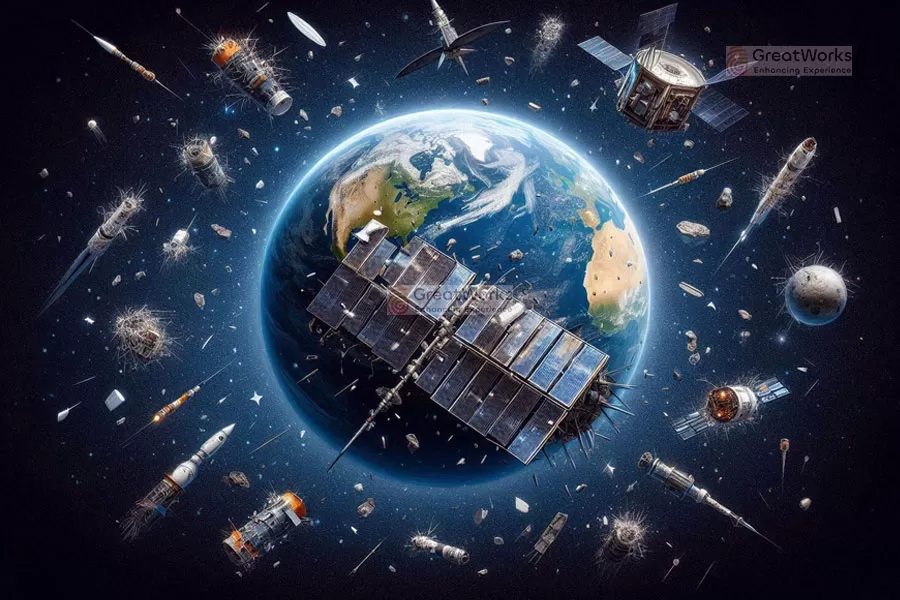
- Services .
- Industries .
- Company .
Explore detailed insights, expert opinions, and updates in our blog. Stay informed, discover new perspectives, and enhance your knowledge with every read.

The Invisible Chaos in Earth's Orbit
High above the atmosphere, Earth's orbit is becoming dangerously congested. What began as a byproduct of the space race has now evolved into a looming environmental hazard: space debris. From retired satellites to fragmented rocket parts, over 130 million pieces of manmade debris—some as small as a grain of sand—are speeding through orbit at tens of thousands of kilometers per hour.
What does this mean for humanity? A potential crisis that could cripple satellite communication, jeopardize space missions, and increase the risk of cascading collisions.
A Growing Cloud of Destruction
According to several tracking agencies, there are currently more than 35,000 pieces of debris larger than 10 cm, and millions more that are untrackable. These objects zip around the Earth in chaotic orbits, capable of damaging or destroying any operational satellite or spacecraft in their path.
At these speeds, even a fleck of paint can tear through spacecraft shielding. The International Space Station (ISS) has had to maneuver out of harm’s way more than 30 times in the past decade—a figure many fear could rise dramatically in the coming years.
The Kessler Syndrome: Collision Cascade
The “Kessler Syndrome,” first proposed by NASA scientist Donald Kessler in 1978, describes a theoretical chain reaction in which orbiting debris collides, creating even more debris, leading to an exponential increase in collisions. Some researchers believe we are now approaching the threshold of this scenario.
One collision between two satellites or a satellite and defunct hardware could generate thousands of new fragments—each a new projectile in the orbital minefield.
The Risks on Earth
Beyond threatening astronauts and space missions, space debris also endangers life on Earth in subtler but impactful ways. Many of the satellites we rely on for weather forecasting, global positioning systems (GPS), financial transactions, agriculture, and communication operate in vulnerable orbits.
A targeted or accidental strike on a key satellite could affect millions. Navigation systems could fail. Weather forecasting might become inaccurate. Entire regions could lose internet access. Some experts warn of "orbital blackouts" if space debris continues to multiply unchecked.
Military Activity and Hidden Tensions
Space is increasingly becoming a contested domain. Some observers believe recent surges in debris may be linked to covert military activity, such as anti-satellite weapon (ASAT) tests or the intentional destruction of aging satellites.
The 2007 Chinese ASAT test and the 2021 Russian test are often cited examples, each creating thousands of high-speed fragments. While officials claim these tests are necessary, critics argue they contribute to a dangerous precedent.
The Race to Clean the Skies
Several space agencies and private companies are working on orbital cleanup technologies. Concepts range from harpoon-equipped satellites to nets, robotic arms, and ground-based lasers that could slow debris enough for it to burn up in Earth’s atmosphere.
Notably:
Still, experts remain skeptical. “We’re deploying solutions, but we’re launching new satellites at an even faster rate,” warned one aerospace researcher.
A Global Governance Gap
Despite the global nature of the threat, there is no unified international treaty specifically addressing the removal of space debris. The 1967 Outer Space Treaty prohibits weaponizing space but is vague on responsibilities for debris cleanup. As a result, regulation lags behind technology—and the risks keep growing.
Without binding laws, many fear the responsibility of cleanup will fall on no one.
What the Future Holds
The commercial space race—fueled by companies like SpaceX, Amazon, and OneWeb—aims to deploy thousands of satellites over the next decade. While these ventures promise innovation and connectivity, they also bring the risk of saturating orbit even further.
If current trends continue unchecked, experts warn that parts of low Earth orbit could become unusable for generations. The consequences could include:
Conclusion: A Call to Action
Space debris may be out of sight, but it should not be out of mind. Governments, industries, and global agencies must act now to regulate launches, enforce debris mitigation, and invest in active cleanup technologies. Otherwise, the dream of a safe and sustainable future in space could be derailed by the very things we've left behind.
The sky may look clear—but space is far from empty.

Top Tech Blogs for 2025: Founders, Facts & Insights

Microsoft Azure Growth Forecast Boosts Stock 7%

AI Replacing Human Jobs: Myth or Reality in 2025?

Case Study: Salon App That Automated 80% of Bookings

Case Study: 250% Order Growth with Food App

Case Study: 3X Growth Using a Custom Mobile App

10 Website Mistakes That Hurt Your Business in 2025

How to Launch an App Successfully in 2025

Why Startups Need Custom Software in 2025

How Mobile Apps Drive Business Growth in 2025